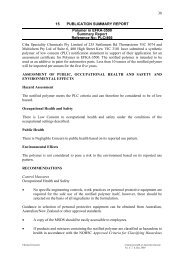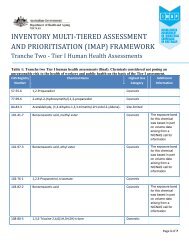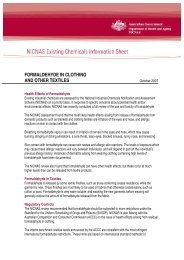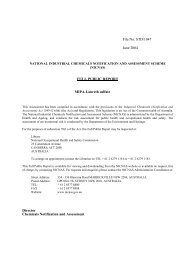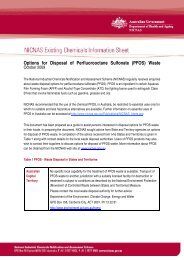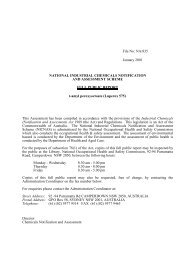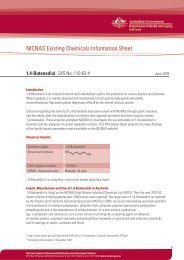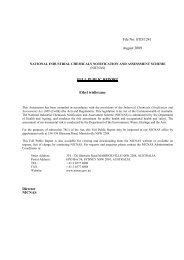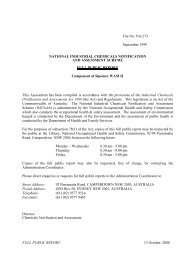26 12 PUBLICATION SUMMARY REPORT Z-51 Summary ... - NICNAS
26 12 PUBLICATION SUMMARY REPORT Z-51 Summary ... - NICNAS
26 12 PUBLICATION SUMMARY REPORT Z-51 Summary ... - NICNAS
Create successful ePaper yourself
Turn your PDF publications into a flip-book with our unique Google optimized e-Paper software.
<strong>12</strong> <strong>PUBLICATION</strong> <strong>SUMMARY</strong> <strong>REPORT</strong><br />
Z-<strong>51</strong><br />
<strong>Summary</strong> Report<br />
Reference No: EX/67<br />
Lubrizol International, Inc. (ARBN 002 747 944) of 28 River Street Silverwater NSW 2<strong>12</strong>8<br />
has submitted a standard notification statement in support of their application for an<br />
assessment certificate for Z-<strong>51</strong>. The notified chemical is intended to be used as a component<br />
of automotive lubricants. The notified chemical will be imported as a component of<br />
concentrate or additive package containing 1 to 10% w/w notified chemical. The imported<br />
product will then be distributed to customers who will formulate the final lubricant. The final<br />
lubricant will contain 0.1 to 1.0% w/w notified chemical. Between 10 and
Occupational Health and Safety<br />
There is Low Concern to occupational health and safety under the conditions of the<br />
occupational settings described.<br />
Public Health<br />
There is No Significant Concern to public health when used as a component of lubricant<br />
product.<br />
Environmental Effects<br />
On the basis of the PEC/PNEC ratio, the chemical is not considered to pose a risk to the<br />
environment based on its reported use pattern.<br />
RECOMMENDATIONS<br />
Regulatory Controls<br />
Hazard Classification and Labelling<br />
• The NOHSC Chemicals Standards Sub-committee should consider the following<br />
health hazard classification for the notified chemical:<br />
− R36/38 – Irritating to eyes and skin<br />
• Use the following risk phrases for products/mixtures containing the notified chemical:<br />
− ≥20%: R36/38 - Irritating to eyes and skin<br />
• Products containing more than 5% notified chemical and available to the public must<br />
carry the following safety directions on the label:<br />
− S24/25: Avoid contact with skin and eyes.<br />
− S37/38/39: Wear suitable protective clothing, gloves, and eye/face protection.<br />
Control Measures<br />
Occupational Health and Safety<br />
• Employers should implement the following engineering controls to minimise<br />
occupational exposure to the notified chemical as introduced:<br />
− Enclosed and automated transfer, mixing and packaging operations<br />
− Exhaust ventilation during manufacture of engine oil products<br />
• Employers should implement the following safe work practices to minimise<br />
occupational exposure during handling of the notified chemical as introduced:<br />
− Avoid splashing during transfer operations and when cleaning equipment<br />
• Employers should ensure that the following personal protective equipment is used by<br />
workers to minimise occupational exposure to the notified chemical as introduced:<br />
− Chemical resistant gloves<br />
− Protective clothing<br />
− Safety goggles<br />
Chemical Gazette Commonwealth of Australia Gazette<br />
No. C 3,1 March 2005<br />
27
Guidance in selection of personal protective equipment can be obtained from Australian,<br />
Australian/New Zealand or other approved standards.<br />
• A copy of the MSDS should be easily accessible to employees.<br />
• If products and mixtures containing the notified chemical are classified as hazardous<br />
to health in accordance with the NOHSC Approved Criteria for Classifying<br />
Hazardous Substances, workplace practices and control procedures consistent with<br />
provisions of State and Territory hazardous substances legislation must be in<br />
operation.<br />
Environment<br />
Disposal<br />
• The notified chemical should be disposed of in a manner consistent with local<br />
jurisdiction waste management regulations by incineration or recycling. Emptied<br />
containers should be recycled or sent to landfill for disposal.<br />
Emergency procedures<br />
• Spills/release of engine oils containing the notified chemical not be released to<br />
waterways or sewer. Spills/leaks should be contained by applying absorbent materials<br />
to the spill or pumping to spilled material into labelled containers. Where feasible and<br />
appropriate, remove contaminated soil. Place contaminated materials in disposable<br />
containers and dispose of in a manner consistent with local jurisdiction waste<br />
management regulations.<br />
Secondary Notification<br />
The Director of Chemicals Notification and Assessment must be notified in writing within 28<br />
days by the notifier, other importer or manufacturer:<br />
Under Section 64(2) of the Act:<br />
− if any of the circumstances listed in the subsection arise.<br />
The Director will then decide whether secondary notification is required.<br />
No additional secondary notification conditions are stipulated.<br />
Chemical Gazette Commonwealth of Australia Gazette<br />
No. C 3,1 March 2005<br />
28
13 <strong>PUBLICATION</strong> <strong>SUMMARY</strong> <strong>REPORT</strong><br />
NT-<strong>26</strong><br />
<strong>Summary</strong> Report<br />
Reference No: PLC/508<br />
Canon Australia Pty. Ltd. (ABN 660050029<strong>51</strong>) of 1 Thomas Holt Drive North Ryde, NSW<br />
2113 has submitted a synthetic polymer of low concern (PLC) notification statement in<br />
support of their application for an assessment certificate for NT-<strong>26</strong>. The notified polymer is<br />
intended to be used as an ingredient in photocopying toner. Less than 1 tonne of the notified<br />
polymer will be imported per annum for each of the first five years.<br />
ASSESSMENT OF PUBLIC, OCCUPATIONAL HEALTH AND SAFETY AND<br />
ENVIRONMENTAL EFFECTS<br />
Hazard Assessment<br />
The notified polymer was negative in a bacterial mutagenicity test. No other toxicity data<br />
have been provided. The notified polymer meets the PLC criteria and can therefore be<br />
considered to be of low hazard. The powder may cause mechanical irritation to the eyes, and<br />
to the respiratory tract if inhaled.<br />
Occupational Health and Safety<br />
There is Low Concern to occupational health and safety under the conditions of the<br />
occupational settings described.<br />
Public Health<br />
There is Low Concern to public health when used in the proposed manner.<br />
Environmental Effects<br />
The notified polymer is not considered to pose a risk to the environment based on its reported<br />
use pattern.<br />
RECOMMENDATIONS<br />
Control Measures<br />
Occupational Health and Safety<br />
• No specific engineering controls, work practices or personal protective equipment are<br />
required for the safe use of the notified polymer itself, however, these should be<br />
selected on the basis of all ingredients in the formulation.<br />
Guidance in selection of personal protective equipment can be obtained from Australian,<br />
Australian/New Zealand or other approved standards.<br />
• Service personnel should wear cotton or disposable gloves and ensure adequate<br />
ventilation is present when removing spent printer cartridges containing the notified<br />
polymer and during routine maintenance and repairs.<br />
Chemical Gazette Commonwealth of Australia Gazette<br />
No. C 3,1 March 2005<br />
29
• A copy of the MSDS should be easily accessible to employees.<br />
Disposal<br />
• The notified polymer should be disposed of to landfill or by incineration.<br />
• The toner or toner container or cartridge should not be put into fire as heated toner<br />
may cause severe burns. The toner container holding remaining toner or toner<br />
cartridge should not be shredded unless dust-explosion preventing measures are taken<br />
as finely dispersed particles form explosive mixtures in air. Disposal should be<br />
subject to Federal, State and Local laws.<br />
Emergency procedures<br />
• No toner spillage occurs in normal operations of handling. If it should occur, avoid<br />
inhalation of the dust. Sweep material onto paper and carefully transfer to a sealable<br />
waste container. Clean remainder with wet paper, wet cloth or a vacuum cleaner. If a<br />
vacuum cleaner is used, it must rate as a dust explosion-proof type. Fine powder can<br />
form explosive dust-air mixtures.<br />
Secondary Notification<br />
The Director of Chemicals Notification and Assessment must be notified in writing within 28<br />
days by the notifier, other importer or manufacturer:<br />
Under subsection 64(1) of the Act; if<br />
− the notified polymer is introduced in a chemical form that does not meet the PLC<br />
criteria.<br />
or<br />
Under subsection 64(2) of the Act:<br />
- if any of the circumstances listed in the subsection arise.<br />
The Director will then decide whether secondary notification is required.<br />
No additional secondary notification conditions are stipulated.<br />
Chemical Gazette Commonwealth of Australia Gazette<br />
No. C 3,1 March 2005<br />
30
14 <strong>PUBLICATION</strong> <strong>SUMMARY</strong> <strong>REPORT</strong><br />
NT-31<br />
<strong>Summary</strong> Report<br />
Reference No: PLC/509<br />
Canon Australia Pty. Ltd. (ABN 660050029<strong>51</strong>) of 1 Thomas Holt Drive North Ryde, NSW<br />
2113 has submitted a synthetic polymer of low concern (PLC) notification statement in<br />
support of their application for an assessment certificate for NT-31. The notified polymer is<br />
intended to be used as an ingredient in photocopying toner. One to ten tonnes of the notified<br />
polymer will be imported in the first year and ten to one hundred tonnes of the notified<br />
polymer will be imported per annum for the remaining four years.<br />
ASSESSMENT OF PUBLIC, OCCUPATIONAL HEALTH AND SAFETY AND<br />
ENVIRONMENTAL EFFECTS<br />
Hazard Assessment<br />
Acute toxicity.<br />
The notified polymer was of low oral toxicity in an acute rat study.<br />
Irritation and Sensitisation.<br />
The notified polymer was found to be very slightly irritating to skin and eyes in rabbits. The<br />
notified polymer was negative in a skin sensitisation test in guinea pigs.<br />
The powder may cause mechanical irritation to the eyes, and to the respiratory tract if<br />
inhaled.<br />
Mutagenicity<br />
The notified polymer was negative in an Ames test.<br />
In addition, the notified polymer meets the PLC criteria and can therefore be considered to be<br />
of low hazard.<br />
Occupational Health and Safety<br />
There is Low Concern to occupational health and safety under the conditions of the<br />
occupational settings described.<br />
Public Health<br />
There is Low Concern to public health when used in the proposed manner.<br />
Environmental Effects<br />
The notified polymer is not considered to pose a risk to the environment based on its reported<br />
use pattern.<br />
RECOMMENDATIONS<br />
Control Measures<br />
Occupational Health and Safety<br />
Chemical Gazette Commonwealth of Australia Gazette<br />
No. C 3,1 March 2005<br />
31
• No specific engineering controls, work practices or personal protective equipment are<br />
required for the safe use of the notified polymer itself, however, these should be<br />
selected on the basis of all ingredients in the formulation.<br />
Guidance in selection of personal protective equipment can be obtained from Australian,<br />
Australian/New Zealand or other approved standards.<br />
• Service personnel should wear cotton or disposable gloves and ensure adequate<br />
ventilation is present when removing spent printer cartridges containing the notified<br />
polymer and during routine maintenance and repairs.<br />
• A copy of the MSDS should be easily accessible to employees.<br />
Disposal<br />
• The notified polymer should be disposed of to landfill or by incineration.<br />
• DO NOT put toner or toner container or cartridge into fire; heated toner may cause<br />
severe burns. DO NOT shred a toner container holding remaining toner or toner<br />
cartridge, unless dust-explosion preventing measures are taken. Finely dispersed<br />
particles form explosive mixtures in air. Disposal should be subject to federal, state or<br />
local laws.<br />
Emergency procedures<br />
• No toner spillage occurs in normal operations of handling. If it should occur, avoid<br />
inhalation of the dust. Sweep material onto paper and carefully transfer to a sealable<br />
waste container. Clean remainder with wet paper, wet cloth or a vacuum cleaner. If a<br />
vacuum cleaner is used, it must rate as a dust explosion-proof type. Fine powder can<br />
form explosive dust-air mixtures.<br />
Secondary Notification<br />
The Director of Chemicals Notification and Assessment must be notified in writing within 28<br />
days by the notifier, other importer or manufacturer:<br />
Under subsection 64(1) of the Act; if<br />
− the notified polymer is introduced in a chemical form that does not meet the PLC<br />
criteria.<br />
or<br />
Under subsection 64(2) of the Act:<br />
- if any of the circumstances listed in the subsection arise.<br />
The Director will then decide whether secondary notification is required.<br />
No additional secondary notification conditions are stipulated.<br />
Chemical Gazette Commonwealth of Australia Gazette<br />
No. C 3,1 March 2005<br />
32
15 <strong>PUBLICATION</strong> <strong>SUMMARY</strong> <strong>REPORT</strong><br />
AI-277-<strong>26</strong><br />
<strong>Summary</strong> Report<br />
Reference No: PLC/5<strong>12</strong><br />
Carter Holt Harvey (ABN: 77 000 601 892) of Como Office Tower, 644 Chapel Street,<br />
South Yarra VIC 3141 has submitted a synthetic polymer of low concern (PLC) notification<br />
statement in support of their application for an assessment certificate for AI-277-<strong>26</strong>. The<br />
notified polymer is intended to be used as a component of printing inks. Up to 100 tonnes of<br />
the notified polymer will be imported per annum for each of the first five years.<br />
ASSESSMENT OF PUBLIC, OCCUPATIONAL HEALTH AND SAFETY AND<br />
ENVIRONMENTAL EFFECTS<br />
Hazard Assessment<br />
The notified polymer contains combined rosin that is not likely to cause sensitisation.<br />
However, up to 11% residual rosin monomers are present. Thus, the product described in the<br />
MSDS is classified as R43, and may cause sensitisation by skin contact.<br />
However, analogous polymers have been shown not to be sensitisers. Also the notified<br />
polymer meets the PLC criteria and can therefore be considered to be of low hazard.<br />
Occupational Health and Safety<br />
There is Low Concern to occupational health and safety under the conditions of the<br />
occupational settings described.<br />
Public Health<br />
There is Negligible Concern to public health when used in the proposed manner.<br />
Environmental Effects<br />
The polymer is not considered to pose a risk to the environment based on its reported use<br />
pattern.<br />
RECOMMENDATIONS<br />
Control Measures<br />
Occupational Health and Safety<br />
• Employers should implement the following safe work practices to minimise<br />
occupational exposure during use of the notified chemical:<br />
− Prevent splashes and spills.<br />
• Service personnel should wear long impervious PVC gloves and overalls and ensure<br />
adequate ventilation is present during routine maintenance and repairs.<br />
Guidance in selection of personal protective equipment can be obtained from<br />
Australian, Australian/New Zealand or other approved standards.<br />
• A copy of the MSDS should be easily accessible to employees.<br />
• Products and mixtures containing the notified polymer may be classified as hazardous<br />
to health in accordance with the NOHSC Approved Criteria for Classifying<br />
Chemical Gazette Commonwealth of Australia Gazette<br />
No. C 3,1 March 2005<br />
33
Environment<br />
Hazardous Substances, and workplace practices and control procedures consistent<br />
with provisions of State and Territory hazardous substances legislation must be in<br />
operation.<br />
• The following control measures should be implemented by end users to minimise<br />
environmental exposure during use of the notified polymer in the manufacture of<br />
printed documents:<br />
− Do not allow material or contaminated packaging to enter drains, sewers or water<br />
courses.<br />
Disposal<br />
• The notified polymer should be disposed of by landfill or incineration.<br />
Emergency procedures<br />
• As products and mixtures containing the notified polymer are classified as hazardous<br />
to health in accordance with the NOHSC Approved Criteria for Classifying<br />
Hazardous Substances, workplace practices and control procedures consistent with<br />
provisions of State and Territory hazardous substances legislation must be in<br />
operation.<br />
Secondary Notification<br />
The Director of Chemicals Notification and Assessment must be notified in writing within 28<br />
days by the notifier, other importer or manufacturer:<br />
Under subsection 64(1) of the Act; if<br />
− the notified polymer is introduced in a chemical form that does not meet the PLC<br />
criteria.<br />
or<br />
Under subsection 64(2) of the Act:<br />
- if any of the circumstances listed in the subsection arise.<br />
The Director will then decide whether secondary notification is required.<br />
Chemical Gazette Commonwealth of Australia Gazette<br />
No. C 3,1 March 2005<br />
34
16 <strong>PUBLICATION</strong> <strong>SUMMARY</strong> <strong>REPORT</strong><br />
AI-270-140<br />
<strong>Summary</strong> Report<br />
Reference No: PLC/<strong>51</strong>3<br />
Carter Holt Harvey (ABN: 77 000 601 892) of Como Office Tower, 644 Chapel Street,<br />
South Yarra VIC 3141 has submitted a synthetic polymer of low concern (PLC) notification<br />
statement in support of their application for an assessment certificate for AI-270-140. The<br />
notified polymer is intended to be used as a component of printing inks. Up to 100 tonnes of<br />
the notified polymer will be imported per annum for each of the first five years.<br />
ASSESSMENT OF PUBLIC, OCCUPATIONAL HEALTH AND SAFETY AND<br />
ENVIRONMENTAL EFFECTS<br />
Hazard Assessment<br />
The notified polymer contains combined rosin that is not likely to cause sensitisation.<br />
However, up to 11% residual rosin monomers are present. Thus, the product described in the<br />
MSDS is classified as R43, and may cause sensitisation by skin contact.<br />
However, analogous polymers have been shown not to be sensitisers. Also the notified<br />
polymer meets the PLC criteria and can therefore be considered to be of low hazard.<br />
Occupational Health and Safety<br />
There is Low Concern to occupational health and safety under the conditions of the<br />
occupational settings described.<br />
Public Health<br />
There is Negligible Concern to public health when used in the proposed manner.<br />
Environmental Effects<br />
The polymer is not considered to pose a risk to the environment based on its reported use<br />
pattern.<br />
RECOMMENDATIONS<br />
Control Measures<br />
Occupational Health and Safety<br />
• Employers should implement the following safe work practices to minimise<br />
occupational exposure during use of the notified chemical:<br />
− Prevent splashes and spills.<br />
• Service personnel should wear long impervious PVC gloves and overalls and ensure<br />
adequate ventilation is present during routine maintenance and repairs.<br />
Guidance in selection of personal protective equipment can be obtained from Australian,<br />
Australian/New Zealand or other approved standards.<br />
• A copy of the MSDS should be easily accessible to employees.<br />
• Products and mixtures containing the notified polymer may be classified as hazardous<br />
to health in accordance with the NOHSC Approved Criteria for Classifying<br />
Chemical Gazette Commonwealth of Australia Gazette<br />
No. C 3,1 March 2005<br />
35
Environment<br />
Hazardous Substances, and workplace practices and control procedures consistent<br />
with provisions of State and Territory hazardous substances legislation must be in<br />
operation.<br />
• The following control measures should be implemented by end users to minimise<br />
environmental exposure during use of the notified polymer in the manufacture of<br />
printed documents:<br />
− Do not allow material or contaminated packaging to enter drains, sewers or water<br />
courses.<br />
Disposal<br />
• The notified polymer should be disposed of by landfill or incineration.<br />
Emergency procedures<br />
• As products and mixtures containing the notified polymer are classified as hazardous<br />
to health in accordance with the NOHSC Approved Criteria for Classifying<br />
Hazardous Substances, workplace practices and control procedures consistent with<br />
provisions of State and Territory hazardous substances legislation must be in<br />
operation.<br />
Secondary Notification<br />
The Director of Chemicals Notification and Assessment must be notified in writing within 28<br />
days by the notifier, other importer or manufacturer:<br />
Under subsection 64(1) of the Act; if<br />
− the notified polymer is introduced in a chemical form that does not meet the PLC<br />
criteria.<br />
or<br />
Under subsection 64(2) of the Act:<br />
- if any of the circumstances listed in the subsection arise.<br />
The Director will then decide whether secondary notification is required.<br />
Chemical Gazette Commonwealth of Australia Gazette<br />
No. C 3,1 March 2005<br />
36
17 <strong>PUBLICATION</strong> <strong>SUMMARY</strong> <strong>REPORT</strong><br />
AI-<strong>26</strong>1-134<br />
<strong>Summary</strong> Report<br />
Reference No: PLC/<strong>51</strong>4<br />
Carter Holt Harvey (ABN: 77 000 601 892) of Como Office Tower, 644 Chapel Street,<br />
South Yarra VIC 3141 has submitted a synthetic polymer of low concern (PLC) notification<br />
statement in support of their application for an assessment certificate for AI-<strong>26</strong>1-134. The<br />
notified polymer is intended to be used as a component of printing inks. Up to 100 tonnes of<br />
the notified polymer will be imported per annum for each of the first five years.<br />
ASSESSMENT OF PUBLIC, OCCUPATIONAL HEALTH AND SAFETY AND<br />
ENVIRONMENTAL EFFECTS<br />
Hazard Assessment<br />
The notified polymer contains combined rosin that is not likely to cause sensitisation.<br />
However, up to 11% residual rosin monomers are present. Thus, the product described in the<br />
MSDS is classified as R43, and may cause sensitisation by skin contact.<br />
However, analogous polymers have been shown not to be sensitisers. Also the notified<br />
polymer meets the PLC criteria and can therefore be considered to be of low hazard.<br />
Occupational Health and Safety<br />
There is Low Concern to occupational health and safety under the conditions of the<br />
occupational settings described.<br />
Public Health<br />
There is Negligible Concern to public health when used in the proposed manner.<br />
Environmental Effects<br />
The polymer is not considered to pose a risk to the environment based on its reported use<br />
pattern.<br />
RECOMMENDATIONS<br />
Control Measures<br />
Occupational Health and Safety<br />
• Employers should implement the following safe work practices to minimise<br />
occupational exposure during use of the notified chemical:<br />
− Prevent splashes and spills.<br />
• Service personnel should wear long impervious PVC gloves and overalls and ensure<br />
adequate ventilation is present during routine maintenance and repairs.<br />
Guidance in selection of personal protective equipment can be obtained from Australian,<br />
Australian/New Zealand or other approved standards.<br />
Chemical Gazette Commonwealth of Australia Gazette<br />
No. C 3,1 March 2005<br />
37
• A copy of the MSDS should be easily accessible to employees.<br />
• Products and mixtures containing the notified polymer may be classified as hazardous<br />
to health in accordance with the NOHSC Approved Criteria for Classifying<br />
Hazardous Substances, and workplace practices and control procedures consistent<br />
with provisions of State and Territory hazardous substances legislation must be in<br />
operation.<br />
Environment<br />
• The following control measures should be implemented by end users to minimise<br />
environmental exposure during use of the notified polymer in the manufacture of<br />
printed documents:<br />
− Do not allow material or contaminated packaging to enter drains, sewers or water<br />
courses.<br />
Disposal<br />
• The notified polymer should be disposed of by landfill or incineration.<br />
Emergency procedures<br />
• As products and mixtures containing the notified polymer are classified as hazardous<br />
to health in accordance with the NOHSC Approved Criteria for Classifying<br />
Hazardous Substances, workplace practices and control procedures consistent with<br />
provisions of State and Territory hazardous substances legislation must be in<br />
operation.<br />
Secondary Notification<br />
The Director of Chemicals Notification and Assessment must be notified in writing within 28<br />
days by the notifier, other importer or manufacturer:<br />
Under subsection 64(1) of the Act; if<br />
− the notified polymer is introduced in a chemical form that does not meet the PLC<br />
criteria.<br />
or<br />
Under subsection 64(2) of the Act:<br />
- if any of the circumstances listed in the subsection arise.<br />
The Director will then decide whether secondary notification is required.<br />
Chemical Gazette Commonwealth of Australia Gazette<br />
No. C 3,1 March 2005<br />
38
18 <strong>PUBLICATION</strong> <strong>SUMMARY</strong> <strong>REPORT</strong><br />
AI-270-116<br />
<strong>Summary</strong> Report<br />
Reference No: PLC/<strong>51</strong>5<br />
Carter Holt Harvey (ABN: 77 000 601 892) of Como Office Tower, 644 Chapel Street,<br />
SOUTH YARRA VICTORIA 3141 has submitted a synthetic polymer of low concern (PLC)<br />
notification statement in support of their application for an assessment certificate for AI-270-<br />
116. The notified polymer is intended to be used as a component of printing inks. Up to<br />
100 tonnes of the notified polymer will be imported per annum for each of the first five<br />
years.<br />
ASSESSMENT OF PUBLIC, OCCUPATIONAL HEALTH AND SAFETY AND<br />
ENVIRONMENTAL EFFECTS<br />
Hazard Assessment<br />
The notified polymer contains combined rosin that is not likely to cause sensitisation.<br />
However, up to 15% residual rosin monomers are present. Thus, the product described in the<br />
MSDS is classified as R43, and may cause sensitisation by skin contact.<br />
However, analogous polymers have been shown not to be sensitisers. Also the notified<br />
polymer meets the PLC criteria and can therefore be considered to be of low hazard.<br />
Occupational Health and Safety<br />
There is Low Concern to occupational health and safety under the conditions of the<br />
occupational settings described.<br />
Public Health<br />
There is Negligible Concern to public health when used in the proposed manner.<br />
Environmental Effects<br />
The polymer is not considered to pose a risk to the environment based on its reported use<br />
pattern.<br />
RECOMMENDATIONS<br />
Control Measures<br />
Occupational Health and Safety<br />
• Employers should implement the following safe work practices to minimise<br />
occupational exposure during use of the notified chemical:<br />
− Prevent splashes and spills.<br />
• Service personnel should wear long impervious PVC gloves and overalls and ensure<br />
adequate ventilation is present during routine maintenance and repairs.<br />
Chemical Gazette Commonwealth of Australia Gazette<br />
No. C 3,1 March 2005<br />
39
Guidance in selection of personal protective equipment can be obtained from Australian,<br />
Australian/New Zealand or other approved standards.<br />
• A copy of the MSDS should be easily accessible to employees.<br />
• Products and mixtures containing the notified polymer may be classified as hazardous<br />
to health in accordance with the NOHSC Approved Criteria for Classifying<br />
Hazardous Substances, and workplace practices and control procedures consistent<br />
with provisions of State and Territory hazardous substances legislation must be in<br />
operation.<br />
Environment<br />
• The following control measures should be implemented by end users to minimise<br />
environmental exposure during use of the notified polymer in the manufacture of<br />
printed documents:<br />
− Do not allow material or contaminated packaging to enter drains, sewers or water<br />
courses.<br />
Disposal<br />
• The notified polymer should be disposed of by landfill or incineration.<br />
Emergency procedures<br />
• As products and mixtures containing the notified polymer are classified as hazardous<br />
to health in accordance with the NOHSC Approved Criteria for Classifying<br />
Hazardous Substances, workplace practices and control procedures consistent with<br />
provisions of State and Territory hazardous substances legislation must be in<br />
operation.<br />
Secondary Notification<br />
The Director of Chemicals Notification and Assessment must be notified in writing within 28<br />
days by the notifier, other importer or manufacturer:<br />
Under subsection 64(1) of the Act; if<br />
− the notified polymer is introduced in a chemical form that does not meet the PLC<br />
criteria.<br />
or<br />
Under subsection 64(2) of the Act:<br />
- if any of the circumstances listed in the subsection arise.<br />
The Director will then decide whether secondary notification is required.<br />
Chemical Gazette Commonwealth of Australia Gazette<br />
No. C 3,1 March 2005<br />
40
19 <strong>PUBLICATION</strong> <strong>SUMMARY</strong> <strong>REPORT</strong><br />
SI-310-43<br />
<strong>Summary</strong> Report<br />
Reference No: PLC/<strong>51</strong>6<br />
Carter Holt Harvey (ABN: 77 000 601 892) of Como Office Tower, 644 Chapel Street,<br />
South Yarra VIC 3141 has submitted a synthetic polymer of low concern (PLC) notification<br />
statement in support of their application for an assessment certificate for SI-310-43. The<br />
notified polymer is intended to be used as a component of printing inks. Up to 100 tonnes of<br />
the notified polymer will be imported per annum for each of the first five years.<br />
ASSESSMENT OF PUBLIC, OCCUPATIONAL HEALTH AND SAFETY AND<br />
ENVIRONMENTAL EFFECTS<br />
Hazard Assessment<br />
The notified polymer contains combined rosin that is not likely to cause sensitisation.<br />
However, up to 11% residual rosin monomers are present. Thus, the product described in the<br />
MSDS is classified as R43, and may cause sensitisation by skin contact.<br />
However, analogous polymers have been shown not to be sensitisers. Also the notified<br />
polymer meets the PLC criteria and can therefore be considered to be of low hazard.<br />
Occupational Health and Safety<br />
There is Low Concern to occupational health and safety under the conditions of the<br />
occupational settings described.<br />
Public Health<br />
There is Negligible Concern to public health when used in the proposed manner.<br />
Environmental Effects<br />
The polymer is not considered to pose a risk to the environment based on its reported use<br />
pattern.<br />
RECOMMENDATIONS<br />
Control Measures<br />
Occupational Health and Safety<br />
• Employers should implement the following safe work practices to minimise<br />
occupational exposure during use of the notified chemical:<br />
− Prevent splashes and spills.<br />
• Service personnel should wear long impervious PVC gloves and overalls and ensure<br />
adequate ventilation is present during routine maintenance and repairs.<br />
Guidance in selection of personal protective equipment can be obtained from Australian,<br />
Australian/New Zealand or other approved standards.<br />
Chemical Gazette Commonwealth of Australia Gazette<br />
No. C 3,1 March 2005<br />
41
• A copy of the MSDS should be easily accessible to employees.<br />
• Products and mixtures containing the notified polymer may be classified as hazardous<br />
to health in accordance with the NOHSC Approved Criteria for Classifying<br />
Hazardous Substances, and workplace practices and control procedures consistent<br />
with provisions of State and Territory hazardous substances legislation must be in<br />
operation.<br />
Environment<br />
• The following control measures should be implemented by end users to minimise<br />
environmental exposure during use of the notified polymer in the manufacture of<br />
printed documents:<br />
− Do not allow material or contaminated packaging to enter drains, sewers or water<br />
courses.<br />
Disposal<br />
• The notified polymer should be disposed of by landfill or incineration.<br />
Emergency procedures<br />
• As products and mixtures containing the notified polymer are classified as hazardous<br />
to health in accordance with the NOHSC Approved Criteria for Classifying<br />
Hazardous Substances, workplace practices and control procedures consistent with<br />
provisions of State and Territory hazardous substances legislation must be in<br />
operation.<br />
Secondary Notification<br />
The Director of Chemicals Notification and Assessment must be notified in writing within 28<br />
days by the notifier, other importer or manufacturer:<br />
Under subsection 64(1) of the Act; if<br />
− the notified polymer is introduced in a chemical form that does not meet the PLC<br />
criteria.<br />
or<br />
Under subsection 64(2) of the Act:<br />
- if any of the circumstances listed in the subsection arise.<br />
The Director will then decide whether secondary notification is required.<br />
Chemical Gazette Commonwealth of Australia Gazette<br />
No. C 3,1 March 2005<br />
42
20 <strong>PUBLICATION</strong> <strong>SUMMARY</strong> <strong>REPORT</strong><br />
2-propenoic acid, butyl ester, polymer with diethenylbenzene and<br />
ethenylbenzene<br />
<strong>Summary</strong> Report<br />
Reference No: PLC/<strong>51</strong>9<br />
Kodak (Australasia) Pty Ltd (ABN 49 004 057 621) of 173 Elizabeth Street Coburg<br />
VIC 3058 and IBM Australia Ltd (ABN 79 000 024 733) of Level 13, IBM Centre, 601<br />
Pacific Highway St Leonards NSW 2065 have submitted a synthetic polymer of low concern<br />
(PLC) notification statement in support of their joint application for an assessment certificate<br />
for 2-propenoic acid, butyl ester, polymer with diethenylbenzene and ethenylbenzene. The<br />
notified polymer is intended to be used as a component (50-80%) of copier and printer toners<br />
supplied in ready-to-use sealed bottles. Up to 50 tonnes of the notified polymer will be<br />
imported per annum for each of the first five years.<br />
ASSESSMENT OF PUBLIC, OCCUPATIONAL HEALTH AND SAFETY AND<br />
ENVIRONMENTAL EFFECTS<br />
Hazard Assessment<br />
The notified polymer meets the PLC criteria and the available toxicological data supports the<br />
conclusion of low hazard.<br />
Occupational Health and Safety<br />
There is Low Concern to occupational health and safety under the conditions of the<br />
occupational settings described.<br />
Public Health<br />
There is No Significant Concern to public health when used in the proposed manner.<br />
Environmental Effects<br />
The polymer is not considered to pose a risk to the environment based on its reported use<br />
pattern.<br />
RECOMMENDATIONS<br />
Control Measures<br />
Occupational Health and Safety<br />
• No specific engineering controls, work practices or personal protective equipment are<br />
required for the safe use of the notified polymer itself, however, these should be<br />
selected on the basis of all ingredients in the formulation.<br />
Guidance in selection of personal protective equipment can be obtained from Australian,<br />
Australian/New Zealand or other approved standards.<br />
Chemical Gazette Commonwealth of Australia Gazette<br />
No. C 3,1 March 2005<br />
43
• In the interest of occupational health and safety, the following guidelines and<br />
precautions should be observed for use of the notified polymer as introduced as a<br />
component of toner products:<br />
− Wearing cotton or disposable gloves and ensuring adequate ventilation during<br />
replacement of toner bottles, machine maintenance and repair services;<br />
− Adequate induction and training programs for service personnel.<br />
• A copy of the MSDS should be easily accessible to employees.<br />
• If products and mixtures containing the notified polymer are classified as hazardous to<br />
health in accordance with the NOHSC Approved Criteria for Classifying Hazardous<br />
Substances, workplace practices and control procedures consistent with provisions of<br />
State and Territory hazardous substances legislation must be in operation.<br />
Disposal<br />
• The notified polymer should be disposed of in landfill or incineration.<br />
Emergency procedures<br />
• Spills/release of the notified polymer should be handled by sweeping onto suitable<br />
material and transfer to a sealable waste container for appropriate disposal in accord<br />
with government regulations.<br />
Secondary Notification<br />
The Director of Chemicals Notification and Assessment must be notified in writing within 28<br />
days by the notifier, other importer or manufacturer:<br />
Under subsection 64(1) of the Act; if<br />
− the notified polymer is introduced in a chemical form that does not meet the PLC<br />
criteria.<br />
or<br />
Under subsection 64(2) of the Act:<br />
- if any of the circumstances listed in the subsection arise.<br />
The Director will then decide whether secondary notification is required.<br />
Chemical Gazette Commonwealth of Australia Gazette<br />
No. C 3,1 March 2005<br />
44
21 <strong>PUBLICATION</strong> <strong>SUMMARY</strong> <strong>REPORT</strong><br />
2-Butenediol acid (2Z)-polymer with methoxyethene, calcium sodium salt<br />
<strong>Summary</strong> Report<br />
Reference No: PLC/521<br />
ISP Australasia Pty Ltd (ABN 27 000 011 923) of 73-75 Derby Street, Silverwater NSW<br />
2<strong>12</strong>8 has submitted a synthetic polymer of low concern (PLC) notification statement in<br />
support of their application for an assessment certificate for 2-Butenediol acid (2Z)-,<br />
polymer with methoxyethene, calcium sodium salt. The notified polymer is intended to be<br />
used as a film former and fixative for use in denture adhesives. Three to ten tonnes of the<br />
notified polymer will be imported per annum for each of the first five years.<br />
ASSESSMENT OF PUBLIC, OCCUPATIONAL HEALTH AND SAFETY AND<br />
ENVIRONMENTAL EFFECTS<br />
Hazard Assessment<br />
The notified polymer meets the PLC criteria and can therefore be considered to be of low<br />
hazard.<br />
Occupational Health and Safety<br />
There is Low Concern to occupational health and safety under the conditions of the<br />
occupational settings described<br />
Public Health<br />
There is No Significant Concern to public health when used in the proposed manner.<br />
Environmental Effects<br />
The polymer is not considered to pose a risk to the environment based on its reported use<br />
pattern.<br />
RECOMMENDATIONS<br />
Control Measures<br />
Occupational Health and Safety<br />
• In the interest of occupational health and safety, the following guidelines and<br />
precautions should be observed for use of the notified polymer as introduced as<br />
Polymer in Gantrez MS-955:<br />
− Avoid dust formation.<br />
• A copy of the MSDS should be easily accessible to employees.<br />
• If products and mixtures containing the notified polymer are classified as hazardous to<br />
health in accordance with the NOHSC Approved Criteria for Classifying Hazardous<br />
Substances, workplace practices and control procedures consistent with provisions of<br />
State and Territory hazardous substances legislation must be in operation.<br />
Chemical Gazette Commonwealth of Australia Gazette<br />
No. C 3,1 March 2005<br />
45
Environment<br />
• No concentration limits, control measures or monitoring are required in Australia as<br />
the notified polymer is a component of a fully finished, imported product.<br />
Disposal<br />
• No specific disposal requirements are required for the disposal of the notified polymer<br />
in Australia as it is a component of a fully finished, imported product.<br />
Storage<br />
• No specific storage requirements are required for the storage of the notified polymer<br />
in Australia as it is a component of a fully finished, imported product.<br />
Emergency procedures<br />
• No specific handling requirements for spills/release of the notified polymer in<br />
Australia are required as it is a component of a fully finished, imported product.<br />
Transport and Packaging<br />
• No specific transport and packaging requirements for the notified polymer in<br />
Australia is required as it is a component of a fully finished, imported product.<br />
Secondary Notification<br />
The Director of Chemicals Notification and Assessment must be notified in writing within 28<br />
days by the notifier, other importer or manufacturer:<br />
Under subsection 64(1) of the Act; if<br />
− the notified polymer is introduced in a chemical form that does not meet the PLC<br />
criteria.<br />
or<br />
Under subsection 64(2) of the Act:<br />
- if any of the circumstances listed in the subsection arise.<br />
The Director will then decide whether secondary notification is required.<br />
Chemical Gazette Commonwealth of Australia Gazette<br />
No. C 3,1 March 2005<br />
46
22 ACCESS TO FULL PUBLIC <strong>REPORT</strong><br />
<strong>NICNAS</strong> publishes a Full Public Report for each new chemical assessed. These reports are<br />
available for public inspection at the library of the National Occupational Health & Safety<br />
Commission at their Canberra office by appointment only. Please call the library on (02)<br />
6279 1161 or (02) 6279 1163 to arrange to view the Full Public Report.<br />
Reports can also be viewed and downloaded free of charge from our website at<br />
www.nicnas.gov.au. Copies of these reports may also be requested, free of charge, by<br />
contacting the Administration Section of <strong>NICNAS</strong> by phone: (02) 8577 8816 or fax: (02)<br />
8577 8888.<br />
Chemical Gazette Commonwealth of Australia Gazette<br />
No. C 3,1 March 2005<br />
47
PERMIT<br />
NUMBER<br />
23 LOW VOLUME CATEGORY PERMITS<br />
The permits listed in Table 2 were issued to import or manufacture the following chemicals<br />
under section 21U of the Industrial Chemicals (Notification and Assessment) Act 1989. Low<br />
Volume Category Permits are approved for 36 months.<br />
COMPANY<br />
NAME<br />
675 International<br />
Flavours &<br />
Fragrances<br />
(Aust) Pty Ltd<br />
COMPANY<br />
POSTCODE<br />
Table 1<br />
Low Volume Category Permits<br />
CHEMICAL OR TRADE<br />
NAME<br />
3175 Benzoic acid, 2methyl-,<br />
methyl ester<br />
HAZARDOUS<br />
SUBSTANCE<br />
48<br />
USE DATE<br />
ND Cosmetics 20.01.05<br />
ND: not determined; insufficient data available to effect a health effects classification under<br />
Approved Criteria [NOHSC:1008(1999)]<br />
Chemical Gazette Commonwealth of Australia Gazette<br />
No. C 3,1 March 2005
PERMIT<br />
NUMBER<br />
24 COMMERCIAL EVALUATION CATEGORY PERMIT<br />
The permits listed in Table 1 were issued to import or manufacture the following<br />
chemicals for commercial evaluation under section 21G of the Industrial Chemicals<br />
(Notification and Assessment) Act 1989.<br />
PERMIT<br />
NUMBER<br />
COMPANY<br />
NAME<br />
Table 2<br />
Commercial Evaluation Category Permits<br />
COMPANY<br />
POSTCOD<br />
E<br />
CHEMICAL OR<br />
TRADE NAME<br />
603 Qenos Pty Ltd 3018 XCAT TM EZ-<br />
604 Clariant<br />
(Australia) Pty<br />
Ltd<br />
100<br />
3148 COMPONENT<br />
OF<br />
DISSOLVAN<br />
3879-1 CONC.<br />
HAZARDO<br />
US<br />
SUBSTANC<br />
E<br />
49<br />
QUANTITY USE PERIOD<br />
APPROVED<br />
Yes 4000 kg Catalyst 2 yrs<br />
ND 3200 kg Crude Oil<br />
Processing<br />
ND: not determined; insufficient data available to effect a health effects classification<br />
under Approved Criteria [NOHSC:1008(1999)]<br />
Permit conditions have been altered for the permit listed in Table below. The table shows<br />
the current details.<br />
COMPANY NAME POST<br />
CODE<br />
CHEMICAL OR<br />
TRADE NAME<br />
583 Arkema Pty Ltd 3<strong>12</strong>1 Peroxide, bis(1,1dimethylpropyl)<br />
HAZARDOU<br />
S<br />
SUBSTANC<br />
E<br />
1 yr<br />
QUANTITY USE PERIOD<br />
Yes 2500 kg Free radical<br />
polymerisation<br />
initiator<br />
Chemical Gazette Commonwealth of Australia<br />
Gazette<br />
No. C 3,1 March 2005<br />
APPROVE<br />
D<br />
24 months
25 EARLY INTRODUCTION PERMITS FOR NON-HAZARDOUS<br />
INDUSTRIAL CHEMICALS<br />
The permits listed in Table 3 were issued to import or manufacture the following<br />
chemicals prior to the issue of their respective assessment certificates under section 30A<br />
of the Act.<br />
PERMIT<br />
NUMBER<br />
COMPANY<br />
NAME<br />
359 BASF<br />
Australia Ltd<br />
360 AKZO Nobel<br />
Chemicals Pty<br />
Ltd<br />
361 Mitsui & Co<br />
(Austrralia)<br />
Ltd<br />
362 PPG<br />
Industries<br />
Australia Pty<br />
Ltd<br />
363 PPG<br />
Industries<br />
Australia Pty<br />
Ltd<br />
364 PPG<br />
Industries<br />
Australia Pty<br />
Ltd<br />
365 The IPL<br />
Group<br />
Table 3<br />
Early Introduction Permits<br />
CHEMICAL OR<br />
TRADE NAME<br />
Component of<br />
Revolution<br />
Polymer in Watersol<br />
ND-5000<br />
Component of Kaneka<br />
Silyl MAX 9<strong>51</strong> &<br />
Kaneka Silyl MAX 932<br />
USE<br />
Surfactant<br />
50<br />
Component of Automotive coating<br />
Ingredient in sealant & adhesive<br />
Polymer in KZX-115 Component of Automotive Paint<br />
Polymer in KH-7<strong>26</strong> Component of Automotive Paint<br />
Polymer in UX-5210 Component of Automotive Paint<br />
FS-020-200 Toner additive<br />
Chemical Gazette Commonwealth of Australia<br />
Gazette<br />
No. C 3,1 March 2005
<strong>26</strong> NOTICE OF CHEMICALS ELIGIBLE FOR LISTING ON THE<br />
AUSTRALIAN INVENTORY OF CHEMICAL SUBSTANCES FIVE YEARS<br />
AFTER ISSUING OF ASSESSMENT CERTIFICATES<br />
Notice is given in accordance with section 14(1) of the Industrial Chemicals (Notification<br />
and Assessment) Act 1989, that the following chemicals have been added to the<br />
Australian Inventory of Chemical Substances.<br />
Table 4<br />
Chemicals Eligible for Listing on the Australian Inventory of Chemical Substances<br />
CHEMICAL NAME CAS<br />
NUMBER<br />
Siloxanes and Silicones, di-Me, Bu group-<br />
and 3-[(2-methyl-1-oxo-2propenyl)oxy]propyl<br />
group-terminated,<br />
polymers with acrylic acid and<br />
tert-Bu acrylate<br />
Amines, polyethylenepoly-, reaction<br />
products with C14-24 alpha-alkenes-maleic<br />
anhydride polymer, 1,3-dioxolan-2-one and<br />
succinic anhydride monopolyisobutylene<br />
derivs.<br />
Molybdenum, bis(2ethylhexyl)carbamodithioatebis(2ethylhexyl)carbamothioate<br />
oxo thioxo<br />
complexes<br />
1,3-Benzenedimethanamine, N,N,N',N'tetrakis(oxiranylmethyl)-,<br />
polymer with 1,3-<br />
benzenedimethanamine<br />
Siloxanes and Silicones, Me hydrogen,<br />
reaction products with 1-dodecene, 1-<br />
(ethenyloxy)-2-methylpropane and 1-octene<br />
O,O-tert-butyl O-(2-ethylhexyl)<br />
monoperoxycarbonate<br />
2-Propenoic acid, 2-methyl-, butyl ester,<br />
telomer with 1-dodecanethiol and alpha-(2methyl-1-oxo-2-propenyl)-omega-<br />
(isotridecyloxy)poly(oxy-1,2-ethanediyl),<br />
tert-Bu 2-ethylhexaneperoxoate-initiated<br />
2-propenoic acid, 2-methyl-, C<strong>12</strong>-16 alkyl<br />
esters, polymers with 2-hydroxyethyl 2methyl-2-propenoate,<br />
methyl 2-methyl-2propenoate<br />
and octadecyl 2-methyl-2propenoate<br />
MOLECULAR<br />
FORMULA<br />
197863-84-6 Unspecified<br />
211135-20-5 Unspecified<br />
68954-53-0 Unspecified<br />
1301<strong>51</strong>-67-6 (C20H28N2O4.C8H1<br />
2N2)x<br />
777058-56-7 Unspecified<br />
34443-<strong>12</strong>-4 C13H<strong>26</strong>O4<br />
183290-64-4 Unspecified<br />
247592-49-0 Unspecified<br />
Chemical Gazette Commonwealth of Australia<br />
Gazette<br />
No. C 3,1 March 2005<br />
<strong>51</strong>
27 NOTICE OF AMENDMENTS TO THE AUSTRALIAN INVENTORY OF<br />
CHEMICAL SUBSTANCES<br />
Notice is given in accordance with section 20 of the Industrial Chemicals (Notification<br />
and Assessment) Act 1989 (the Act) that the following amendment have been made to the<br />
Australian Inventory of Chemical Substances (AICS).<br />
Table 5<br />
Amendment to AICS<br />
The following CAS number has been deleted from AICS and replaced with the correct<br />
CAS Number, chemical name and molecular formula<br />
DELETED CAS<br />
NUMBER<br />
CHEMICAL NAME CAS<br />
NUMBER<br />
107375-39-8 2-Propenoic acid,<br />
polymer with 2-methyl-<br />
2-[(1-oxo-2propenyl)amino]-1propanesulfonic<br />
acid<br />
monosodium salt and<br />
alpha-(2-methyl-1-oxo-<br />
2-propenyl)-omegahydroxypoly(oxy-1,2ethanediyl)<br />
8500-47-6 Oils, lanolin, 2-<br />
methylpropanoate<br />
58205-96-2 Sorbitan,<br />
diisooctadecanoate,<br />
poly(oxy-1,2-<br />
ethanediyl) derivs.<br />
114040-31-2 L-Ascorbic acid-2phosphate<br />
magnesium<br />
salt<br />
The following invalid CAS number is deleted from AICS<br />
<strong>12</strong>9<strong>12</strong>-39-8<br />
MOLECULAR<br />
FORMULA<br />
99247-63-9 (C7H13NO4S.C3<br />
H4O2.(C2H4O)n<br />
C4H6O2.Na)x<br />
85005-47-6 Unspecified<br />
<strong>12</strong>1854-68-0 Unspecified<br />
23666-04-8 C6H9O9P.Mg<br />
Chemical Gazette Commonwealth of Australia<br />
Gazette<br />
No. C 3,1 March 2005<br />
52
28 NOTICE OF CHEMICALS ELIGIBLE FOR IMMEDIATE LISTING ON<br />
THE AUSTRALIAN INVENTORY OF CHEMICAL SUBSTANCES AFTER<br />
ISSUING OF ASSESSMENT CERTIFICATES<br />
Notice is given in accordance with section 13B of the Industrial Chemicals (Notification<br />
and Assessment) Act 1989, that the following chemicals have been added to the<br />
Australian Inventory of Chemical Substances.<br />
Table 6<br />
Chemicals Eligible for Immediate Listing on the Australian Inventory of Chemical<br />
Substances<br />
CHEMICAL NAME CAS<br />
NUMBER<br />
2-Butenediol acid (2Z)-, polymer with<br />
methoxyethene, calcium sodium salt<br />
MOLECULAR<br />
FORMULA<br />
62386-95-2 (C4H4O4.C3H6O)x.x<br />
Ca.xNa<br />
1,2-Propanediol, 3-[(2-ethylhexyl)oxy]- 70445-33-9 C11H24O3<br />
Oxirane, methyl-, polymer with oxirane,<br />
mono(2-propylheptyl) ether<br />
166736-08-9 C10H22O.<br />
(C3H6O.C2H4O)x<br />
Chemical Gazette Commonwealth of Australia<br />
Gazette<br />
No. C 3,1 March 2005<br />
53



